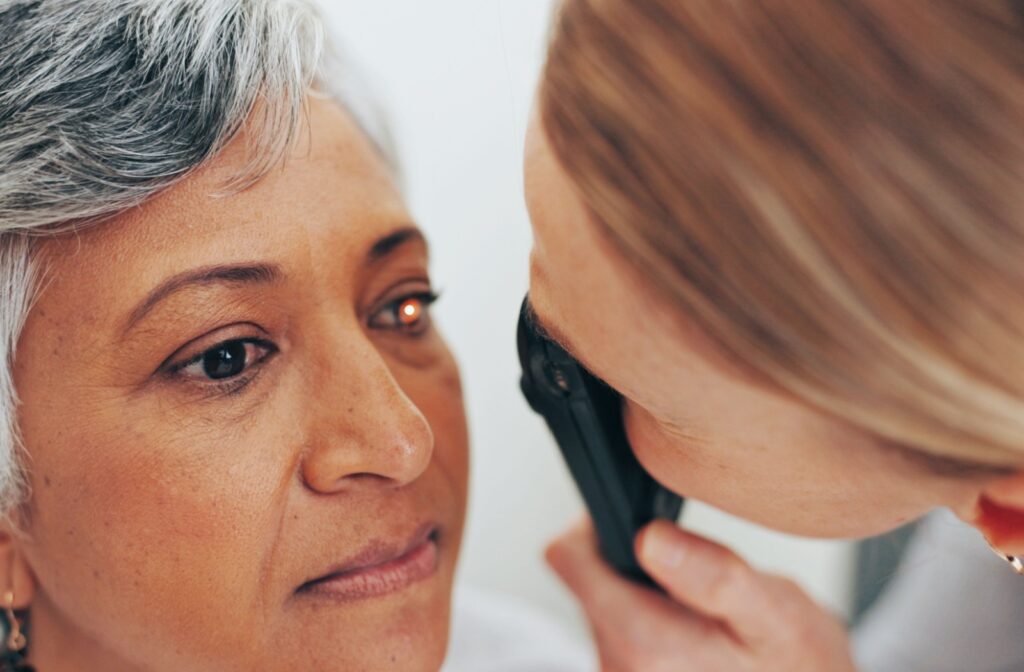Glaucoma often raises questions for families who have seen loved ones struggle with vision loss. Many people wonder whether genetics could put them at risk too, especially when eye health issues seem to run from one generation to the next.
Glaucoma is known to be hereditary, and having a close family member with the condition can significantly raise your own risk.
What Is Glaucoma?
Glaucoma is a group of eye conditions that gradually damage the optic nerve, which connects your eye to your brain. This damage typically occurs when pressure inside your eye (called intraocular pressure) becomes elevated, though it can happen even with normal eye pressure in some cases.
What makes glaucoma particularly dangerous is its silent progression. Often called “the silent thief of sight,” this condition usually develops without noticeable symptoms until significant vision loss has occurred. The peripheral (side) vision is typically affected first, while central vision remains intact until the advanced stages. By the time people notice vision changes, permanent damage may have already occurred.
The optic nerve damage caused by glaucoma is irreversible, making early detection and treatment important for preventing blindness.
How Family History Affects Your Risk
Glaucoma is hereditary. Research consistently shows that having a family member with glaucoma significantly increases your likelihood of developing the condition yourself.
The hereditary nature of glaucoma varies depending on the type. Primary open-angle glaucoma, the most common form, shows particularly strong genetic links. Several genes have been identified that contribute to glaucoma development, affecting how your eyes produce and drain fluid, as well as how susceptible your optic nerve is to pressure-related damage.
However, having a family history doesn’t guarantee you’ll develop glaucoma. Genetics is just one piece of the puzzle. Environmental factors, age, and other health conditions also play important roles in determining your overall risk.
The Different Types of Glaucoma
Open-Angle Glaucoma
Open-angle glaucoma accounts for about 90% of all glaucoma cases and has the strongest hereditary component. This type develops gradually when the eye’s drainage system becomes less efficient over time, causing pressure to build slowly.
The progression is so gradual that most people don’t experience symptoms until significant vision loss has occurred. You might notice:
- Gradual loss of peripheral vision
- Difficulty seeing in low light
- Tunnel vision in advanced stages
Angle-Closure Glaucoma
This less common but more urgent form occurs when the drainage angle becomes completely blocked, causing a rapid spike in eye pressure. Unlike open-angle glaucoma, this type can cause sudden, severe symptoms, including:
- Intense eye discomfort
- Severe headaches
- Nausea and vomiting
- Blurred vision
- Seeing halos around lights
Angle-closure glaucoma is a medical emergency requiring immediate treatment to prevent permanent vision loss.
Normal-Tension Glaucoma
Some people develop optic nerve damage even with normal eye pressure. This form, called normal-tension glaucoma, may be related to poor blood flow to the optic nerve or increased sensitivity to pressure.

Additional Risk Factors Beyond Genetics
While family history increases your glaucoma risk, other factors also contribute to your likelihood of developing this condition:
- Age: Risk increases with age, particularly those over 55.
- Ethnicity: People of African, Hispanic, and Asian descent may face higher risks for certain types of glaucoma.
- Medical conditions: Diabetes, high blood pressure, and heart disease can increase your risk.
- Eye-related factors: Severe nearsightedness, previous eye injuries, and thin corneas contribute to higher glaucoma risk.
- Medications: Long-term use of corticosteroids may increase eye pressure in some people.
Protecting Your Vision
Understanding your family’s glaucoma genetics helps you to take proactive steps for your eye health. Here’s what you can do:
- Know your family history: Talk to your relatives about their eye health. Understanding which family members have had glaucoma and what type can help your eye doctor assess your risk more accurately.
- Schedule regular eye exams: If you have a family history of glaucoma, annual comprehensive eye exams, or earlier if recommended by your eye doctor.
- Maintain overall health: Managing conditions like diabetes and high blood pressure supports your overall eye health.
- Protect your eyes: Wear protective eyewear during sports and activities that could result in eye injury.
- Stay informed: Keep up with new developments in glaucoma research and treatment options.
The Importance of Regular Eye Exams
Since glaucoma typically progresses without symptoms, regular comprehensive eye exams are your best defense against vision loss. During these exams, your eye doctor may:
- Measure your intraocular pressure
- Examine your optic nerve for signs of damage
- Test your peripheral vision
- Measure your corneal thickness
- Assess the drainage angle in your eyes
If you have a family history of glaucoma, these exams become even more important. Early detection allows for treatments that can help to slow or halt the progression of the disease, preserving your remaining vision.
Your Next Steps for Healthy Vision
At Windsor Eye Care, our team understands the importance of comprehensive eye care, especially when family history puts you at higher risk for conditions like glaucoma. We’re committed to providing thorough examinations and personalized care plans that help detect problems early and preserve your vision.
Don’t wait for symptoms to appear. Glaucoma often causes irreversible damage before you notice any changes in your vision. If you have a family history of glaucoma or other risk factors, schedule a comprehensive eye exam with Windsor Eye Care today.





